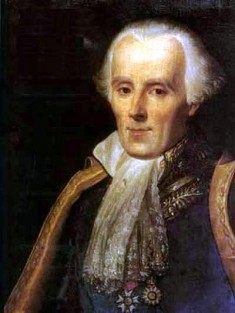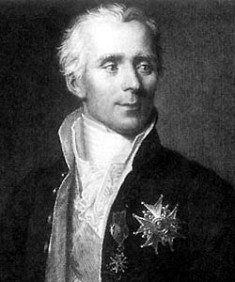| Pierre-Simon Laplace | |
|---|---|
 |
|
| Astronomer & Mathematician | |
| Born | Mar. 23, 1749 Beaumont-en-Auge, Normandy, France |
| Died | Mar. 5, 1827 (at age 77) Paris, France |
| Nationality | French |
Born on March 23, 1749, in Beaumont-en-Auge in Normandy, France, Pierre-Simon Laplace was an eminent astronomer and mathematician and he is regarded as one of the most influential scientists of all time. He is often referred to as the “Newton of France” as he was a pioneer in postulating the notions of gravitational collapse and black holes. He also reformulated the nebular hypothesis regarding the origin of the solar system.
Early Years
Laplace’s father was a cider merchant and farm worker and his mother, Marie-Anne Sochon, came from a wealthy farming family. No academic achievement of his parents is documented, but his father expected him to enter either the Catholic Church or the army.
Pierre-Simon attended a Benedictine priory school until the age of 16, when he enrolled at the University of Caen to study theology, in order to fulfill his parents’ wishes. While studying at Caen, he showed a special interest in mathematics and, encouraged by two math professors, Le Canu and Gadbled, Laplace decided to leave Caen without having earned his degree and go to Paris to pursue a career in mathematics.
With a letter of recommendation from Le Canu to the famous French mathematician d’Alembert, he arrived in Paris, where he managed to really impress d’Alembert with his exceptional intellectual abilities. He was then offered a position as professor of mathematics at the “Ecole Militaire” in Paris and which he gladly accepted. Relieved for having a steady income, between 1771 and 1787 Pierre-Simon Laplace dedicated all his spare time to extensive research in the field of astronomy, which culminated with the publication of his most significant works in astronomy. In 1788, Pierre-Simon Laplace married 18-year old Marie Charlotte de Courty de Romanges in Paris.
Contributions to Astronomy
 In addition to his outstanding contribution to mathematics and mathematical physics, having introduced Laplace’s equation, the Laplacian differential operator and the Laplace transform, the French genius also paved the way in the field of mathematical astronomy and the theory of probability, two areas in which he worked almost his entire life.
In addition to his outstanding contribution to mathematics and mathematical physics, having introduced Laplace’s equation, the Laplacian differential operator and the Laplace transform, the French genius also paved the way in the field of mathematical astronomy and the theory of probability, two areas in which he worked almost his entire life.
Laplace managed to account for all the carefully observed deviations of the planets from their orbits with the aid of Sir Isaac Newton’s gravitation theory, which he applied to the solar system. He started by searching for reasons as to why the orbit of Jupiter appeared to be shrinking while the orbit of Saturn appeared to be expanding.
In 1773, he gave a scientific answer to the great Jupiter-Saturn inequality by announcing the invariability of planetary mean motions or average angular velocity. His theory on planetary motion was the scientific basis for Delambre’s astronomical tables.
More Contributions by LaPlace
In 1796, Pierre-Simon Laplace reformulated the renowned nebular hypothesis (outlined by Kant in 1755) regarding the origin of the solar system, whose evolution had begun with a globular mass of incandescent gas. He also predicted that the planets nearer the sun would be younger than those more distant from the sun.
In 1786, Pierre-Simon Laplace proved that the inclinations and the eccentricities of the planetary orbits to each other remain always constant, self-correcting and small. The famous French astronomer also developed an analytical solution regarding lunar inequalities and explained scientifically the effect known as the secular acceleration of the Moon in 1787, showing that the acceleration is due to important changes in the eccentricity of the Earth’s orbit, which are caused by planetary perturbations. These results regarding the lunar acceleration were used to compile his scientific proof of the stability of the solar system.
Death and Legacy
As an astronomer, he is mostly famous for his in-depth analysis of the stability of the solar system. His 1773 discovery (average angular velocity) is considered a milestone in physical astronomy and it won him that same year an associate membership in the French Academy of Sciences.
His pivotal work in mathematical astronomy is entitled Traite de Mecanique Celeste, which involved decades of original research and it was published in five volumes, the first two volumes in 1799. In 1806, he became Count of the First French Empire and then in 1817, after the restoration of the Bourbons he was named a marquis (he was a supporter of the Bourbon monarchy, which made him unpopular in political circles). His name is among the 72 names inscribed on the Eiffel Tower in Paris.
Pierre-Simon Laplace passed away at the age of 77, on March 5, 1827, in Paris, France. He was survived only by his son, Charles-Emile (born in 1789 and died in 1874), because his only daughter, Sophie-Suzanne, died in 1813, at only 21 years old, during childbirth (her daughter however did survive).